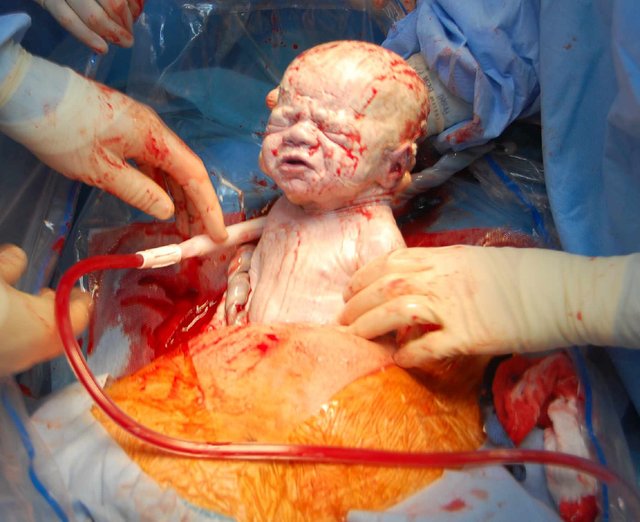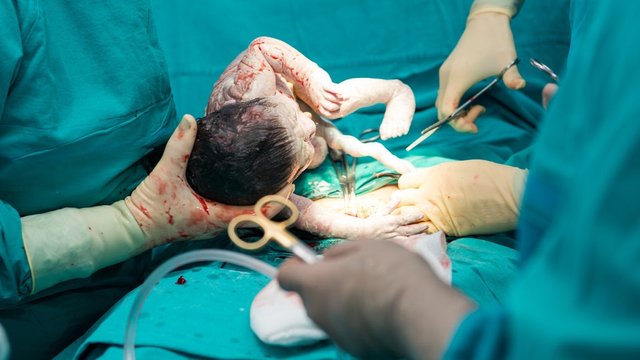CAESARIAN SECTION
Definition
It is an operative procedure whereby the fetus is delivered after the 28th week through an incision on the abdominal and uterine walls.

Indication of caesarian section
A. Absolute indications
- Central placenta preavia
- Contracted pelvis or chephalo-pelvic disproportion (absolute)
- Pelvic mass causing obstruction
- Advanced Ca cervix
- Vaginal obstruction ( stenosis)
B. Relative indications
- Chephalo-pelvic disproportion (relative)
- Previous caesarian section
- Fetal distress ( non reassuring FHR)
- Cervical dystocia- due to
i. Inefficient uterine contraction
ii. Small pelvis
iii. Large fetus - APH
- Malpresentation-brow, breech, shoulder
- Failed surgical induction of labor
- Failure to progress in labor
- Bad obstetric history ( recurrent fetal wastage)
- Hypertensive disorder-eclampsia, preeclampsia
- Medical disorder-heart disease, DM
- Gynaecological disorder- pelvic tumor, repair of VVF.
Common indication of emergency C/S
- CPD
- Contracted pelvis
- APH/Central placenta praevia
- Fetal distress
- Malpresentation
- Failed induction of labor
- Cervical dystocia
Complication of caesarian section
A. Maternal complications
- During operation
i. Uterine laceration
ii. Uterine atony
iii. Extension of uterine incision to one or both side
iv. Cutting of the vessels leading to-
• Severe hemorrhage
• Hypo-volumic shock
• Broad ligament hematoma
v. Primary PPH
vi. Injury to the urinary bladder
vii. Injury to the ureter
viii. Anesthetic hazards - Post-operative complications
i. Immediate
• Post operative bleeding
• Infection
• Secondary PPH
• Septic thrombo-phlebitis
ii. Remote
• Chronic pelvic pain
• Backache
• Menstrual irregularity
• Incisional hernia
• Excessive scar formation
• Risk of scar rupture or rupture of the uterus in subsequent pregnancy.

B. Fetal complication
- Iatrogenic prematurity
- Respiratory distress syndrome
- Birth injury
- Birth asphyxia due to anesthetic hazards.
Management of C/S / Steps of LUCS
- Pre-operative procedures
i. History taking-
• Chief complain-period of amenorrhoea
• History of antenatal checkup
• Obstetric history
• Menstrual history
• H/O significant medical illness
• Drug history-any history of drug sensitivity
• Immunization history- status of immunization against tetanus.
ii. General examination: nutrition, pulse rate, blood pressure, temperature, respiratory rate, anaemia, jaundice, cyanosis, oedema, dehydration, heart, lung, breast.
iii. Systemic examination: CVS and respiratory system examination.
iv. Per-abdominal examination
• Height of the uterus
• Fetal movement
• Four grips- Fundal grip, two lateral grip, pelvic grip
• FHR
v. Investigation
• Blood routine examination: Hb%, TC, DC, ESR, blood grouping & Rh typing, RBS.
• Urine R/E: For pus cell and protein
• USG: to assess fetal wellbeing
• ECG
vi. Written informed consent.
vii. Shaving and cleaning the operative area (mid chest to mid thigh).
viii. Pre-anaesthetic medication-
• Tab.Diazepum (5mg) at bed time may be prescribed at last night.
• NPO from 12 hours before operation. At least 6 hours in case of emergency C/S.
• An intravenous cannula (size-18-20) should be opened 2-3 hours before operation.
• Anti-ulcerative-ing. Pantoprazole (40 mg) should be started to reduce acid secretion.
• Intravenous fluid
- Inf. Hartman’s solution (1000 ml) I/V @ 10-15 drops/min 2-3 hours before operation.
• Prophylactic antibiotic: I/V ceftriaxone is recommended.
Intra-operative procedures
i. Position- supine position.
ii. Anaesthesia: Spinal anesthesia, general anaesthesia, epidural anaesthesia.
iii. Anti-septic wash- mid chest to mid thigh region including vulva and vagina by 10% chlorohexidin solution.
iv. Draping.
v. Proper light.
vi. Incision: Pfennesteil incision is made commonly 3cm above the symphysis pubis.
• Skin, Superficial fascia, the recti and pyramidalis muscles are retracted laterally from the midline.
• A short incision is made in the midline down to the membranes.
• The incision of the lower segment is being enlarged using index finger of both hands.
vii. Delivery of the head.
viii. Delivery of the trunk.
ix. Removal of placenta and membrane by CCT.
x. Securing the bleeding vessels properly.
xi. Suture of the uterine wound.
xii. Closure:
• Peritonium: continuous suture with chromic 1 or 2 catgut in a rounded bodies needle.
• Anterior rectus sheath: continuous suture with chromic 1 or 2 catgut in a cutting bodies needle.
• Subcutaneous tissue: interrupted stich with plain catgut.
• Skin: interrupted silk stitch or subcutaneous (cosmetic purpose).Post operative procedures
‘0’ POD
i. Follow the post operative order-
• NPO till further order
• Inf. 5% DNS (2l)+Inj.Oxytocin (2 amp in each litre of fluid) I/ V @ 30 drops/min.
• Inj. Ceftriaxone (1gm) 1 vial I/V stat and daily.
• Inj. Metronidazole (500mg) 1 bottle I/V stat and daily.
• Inj. Pethidine (100mg) 1 ample I/M stat and SOS.
• Inj. Metoclopramide (12.5 mg) 1 amp I/M stat and SOS.
• Inj. Tramadol (100 mg) 1 amp I/M 12 hourly.
• Inj. Ranitidine (50 mg) 1 amp I/V stat and 8 hourly.
• Diclofenac suppositories (50 mg) 1 stick per-rectally SOS.
• Continue catheter for 3 days ( if obstructed labor the 21 days).
• Change posture at two hours interval.
• Monitor vital signs routinely.
ii. Effective pain management.
iii. Examination of the dressing.
iv. Routine vital signs monitoring.
v. Urine output monitoring.
vi. Auscultation of abdomen for bowel sound.
1st POD
i. I/V fluid continue with sips of water orally.
ii. Early mobilization.
iii. Checking the bandage.
iv. Monitor vital signs.
2nd POD
i. If bowel sound present then liquid diet followed by semisolid food.
ii. I/V fluid reduce to 1 liter.
iii. Antibiotic in oral from.
iv. Catheter should be clamped.
v. Mobilization continue.
vi. Monitor vital signs.
3rd POD
i. If no problem then diet is regular high protein and high fiber diet.
ii. I/V fluid withdrawn.
iii. Catheter withdrawn.
iv. Checking bandage.
v. Monitor vital signs.
4th POD
i. Dressing is done.
ii. Monitor vital signs.
5th POD
i. Continue the same
6th POD
i. If wound is healthy alternate stich may be off.
ii. Continue the same.
7th POD
i. Complete removal of stitch.
ii. Discharge the patient with advice-
• Diet- High nutritious diet containing high class protein, vitamins, minerals, fiber etc.
• Breast feeding
- Exclusive breast feeding for 1st 6th months.
- Extra supplementary food for 1.5 years with breast feeding.
• Contraception - Progesterone only pill for 6 months.
- Barrier methods for next 1 year.
• Coitus - Abstinence for first 3 months.
• Immunization - Immunized the baby according to EPI schedule.
• Birth spacing- at least for 2 years.
• Personal precautions- - Do not bear heavy weight for 6 months.
- Do not strain during defecation.
- Wear abdominal binder for 3 months.
✅ @nnsabunayeem, I gave you an upvote on your first post! Please give me a follow and I will give you a follow in return!
Please also take a moment to read this post regarding bad behavior on Steemit.